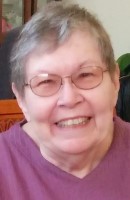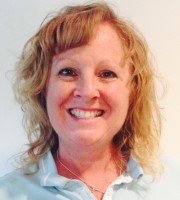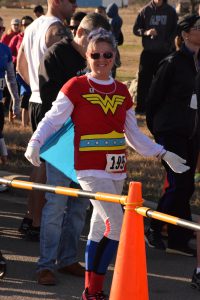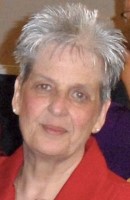
![]()
In 2014 I was diagnosed with endometrial cancer after a hysterectomy and then had 16 lymph nodes removed to determine the stage. Cancer treatment included both chemo and radiation. My lymphedema symptoms began on the day that I had surgery to remove my port in July of 2015. That morning my ankle was swollen for no apparent reason and one of the attending physicians cautioned me to “keep an eye on that,” but offered no further information.
As I tried to get back into shape again I noticed a stretching pain in my inner thigh when I tried to walk fast. I also noticed swelling in my calf but it would go away when I elevated my leg so initially I did not think much about it. After about a month however, my entire leg continued to swell and I knew this was not normal. When I mentioned it to my physician, he told me that it will take some time, but that the swelling will go down as the lymph finds new pathways out of my tissues.
Finally, my radiologist diagnosed the lymphedema and referred me to the LE clinic. I currently have swelling on my left side below my belly button to the ankle, and over my hip. I am however, fortunate that I don’t have swelling in my foot, which is unusual according to my infectious disease physician. I wear boots and gym shoes all the time, so perhaps the compression on my foot helps.
My lymphedema steadily progressed and I had many bouts of cellulitis despite being very compliant with self-management so I got to the point that I decided I had to do something different. My PCP found a surgeon at the University of Washington, about 2 hours’ drive from my home. The results of a lymphoscintigraphy showed that I still had decent lymph vessels in my lower leg. The surgeon agreed that a lympho-venous anastomosis (LVA) would be beneficial for me. The procedure was outpatient. I have two anastomoses near my ankle and 2 mid-shin. The recovery was pretty easy although I wasn’t able to wear compression for 4 weeks after the surgery so I was not able to be as active as I like to be. I could only wear bandages with not more than 10 Hg pressure.
I still wear compression: class 3, flat knit thigh highs. I wear biker shorts over them but have to be careful not to get double compression on my thigh. I use an Entre pump, which I think helps keep the swelling down in my lower leg. I’d love to get a Flexitouch so I can clear the swelling in my abdomen and hip but my insurance won’t cover it. I wear a Jobst Relax at night.
My daily routine consists of doing manual lymph drainage (MLD) in the morning, then putting on my compression. I’m on my feet all day at work but fortunately I don’t have to sit or stand in one place for any length of time so I am constantly on the move.
When I get home at night, I walk or jog – I’m trying to get back to running and am doing more each day. When I exercise, I wear running tights over my compression. I also coach cross country. I stay active and am trying to eat better too – like substituting nuts for cookies. I’m not too good at eating well; my son gave up ice cream for Lent and that’s been a big help for me!
I have a pretty good attitude about my LE. But I get emotional when my leg swells more and is sore. I always wonder what I did to cause it to get worse? I’ve had so many bouts of cellulitis and I don’t know the source. I was hospitalized in November last year. I’ve had cellulitis 7 times since my diagnosis – 5 times since August 2017. I’m now on prophylactic antibiotics but even so, the last 2 times I had cellulitis, I was on antibiotics. It didn’t get septic, so maybe the antibiotics helped with that.
I keep a positive outlook as much as I can. Exercise helps me a lot. I’ve not had cellulitis in 6 weeks, so I can be more consistent with my exercise. The LVA helped the swelling in my calf but my calf still is swollen about 2cm more by the end of the day. I think with compression that shouldn’t happen, so I’m trying to find the right compression for me. I go back to the surgeon in June for more testing and I’m looking forward to that.
Overall, while dealing with LE is difficult, it’s better than the alternative! I am grateful that I have such a supportive husband too. Without him, I wouldn’t be nearly as positive about this disease.
Lisa Garcia
Yakima, Washington







 Hi, my name is Dawn Oswald, 49 years old, and I am a 10-year breast cancer survivor and I have lymphedema (LE). I have been suffering for 6 years with lymphedema. I had stage 2 breast cancer. After receiving chemotherapy and radiation, my physician put me on an estrogen-decreasing medicine for 10 years instead of the 5 years recommended. Taking it for 10 years decreases the chances of the cancer recurring even more than with the 5-year protocol. I told my physician that I would continue paying for the medicine as my life is worth more than the ten dollars per month cost. I have been taking this medicine for the last 9.5 years.
Hi, my name is Dawn Oswald, 49 years old, and I am a 10-year breast cancer survivor and I have lymphedema (LE). I have been suffering for 6 years with lymphedema. I had stage 2 breast cancer. After receiving chemotherapy and radiation, my physician put me on an estrogen-decreasing medicine for 10 years instead of the 5 years recommended. Taking it for 10 years decreases the chances of the cancer recurring even more than with the 5-year protocol. I told my physician that I would continue paying for the medicine as my life is worth more than the ten dollars per month cost. I have been taking this medicine for the last 9.5 years. I completed the 5k I described in my previous post in 31minutes 37 seconds – not bad for this old girl! The photo shows the Wonder Woman outfit I wore on the run.
I completed the 5k I described in my previous post in 31minutes 37 seconds – not bad for this old girl! The photo shows the Wonder Woman outfit I wore on the run.
